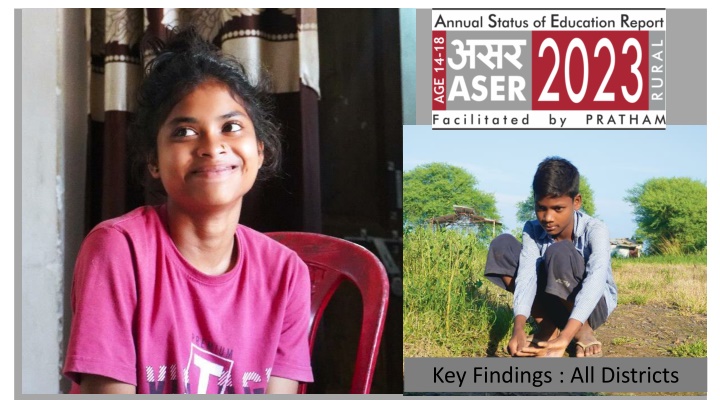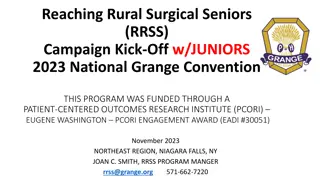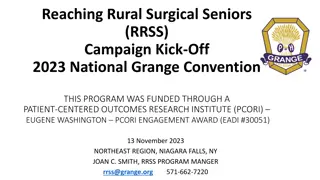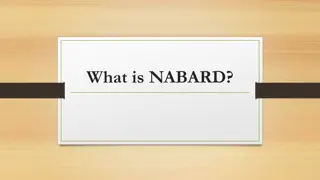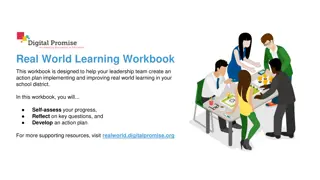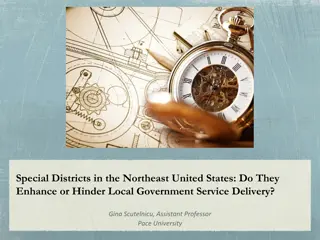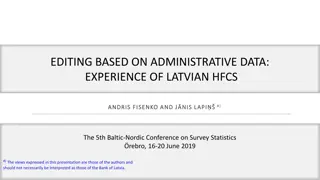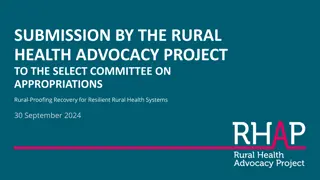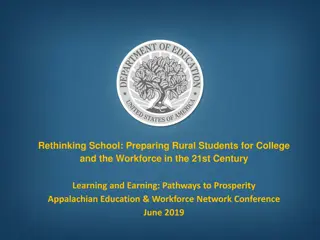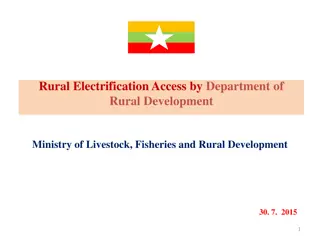Insights from ASER 2023 Household Survey in Rural Districts
ASER 2023 focused on the age group 14-18 in rural districts, exploring domains beyond foundational skills like activity, abilities, and digital device skills. The survey reached 1,664 villages, surveyed 30,074 households, and 34,745 youth. Partners included colleges and universities, with over 2,000 volunteers from 37 institutions involved in conducting the survey, providing valuable insights into the education and activities of youth in this age group.
Download Presentation

Please find below an Image/Link to download the presentation.
The content on the website is provided AS IS for your information and personal use only. It may not be sold, licensed, or shared on other websites without obtaining consent from the author.If you encounter any issues during the download, it is possible that the publisher has removed the file from their server.
You are allowed to download the files provided on this website for personal or commercial use, subject to the condition that they are used lawfully. All files are the property of their respective owners.
The content on the website is provided AS IS for your information and personal use only. It may not be sold, licensed, or shared on other websites without obtaining consent from the author.
E N D
Presentation Transcript
WHY BEYOND BASICS? In India, compulsory education ends at age 14. To work full time in the organized sector you have to be 18. Are our youth adequately prepared for the path ahead for further education, work and life? There are roughly 25 million children in each single year age in India.* In 2005-2006, all India Std VIII enrollment was 11million. By 2020-21, this number was close to 22 million. Transition rate from Std VIII to Std IX is at 88.81% national.** In short, today in India more children have more years of schooling than ever before. Hence, understanding what life is like for young people in the age group 14 to 18 in rural India is very important. * Census projections **Data from UDISE
WHAT IS BEYOND BASICS? ASER 2023 focuses on the age group 14-18 and looks beyond basics to explore a wider set of domains beyond foundational skills. Domains explored in ASER 2023 are: Activity: What are the youth currently doing? School/college, vocational skilling or work. Ability: Are youth well prepared to handle literacy and numeracy tasks in every day situations? Can they do simple financial calculations? Access, Awareness & Skills with digital devices: Are they familiar with common digital devices and usage?
WHERE WAS ASER 2023 DONE ASER 2023 is a household survey done in rural districts. Survey reached: Villages = 1,664 Households = 30,074 14-18 youth surveyed = 34,745 A random sample of 60 villages was visited in each district. The sample for ASER 2023 was limited to 1-2 districts per state. The previous ASER survey that looked closely at the age 14- 18 group was ASER 2017.
WHO WAS INVOLVED IN ASER 2023? Every year, ASER is conducted by one or more partner institutions in each district. Since the focus of ASER 2023 is on an older age group, this year s partners were colleges and universities. Volunteers were typically enrolled in degree programmes such as BSW, MSW, BEd, MEd, etc. Over 2,000 volunteers from 37 partner institutions conducted ASER 2023.
ACTIVITY: WHAT ARE YOUTH (AGE 14-18) CURRENTLY DOING? CURRENTLY ENROLLED Of all youth in the age group 14 to 18: 53% are still in school (Std X or below) 28% are in either Std XI or XII. 7% are in college. 13% are currently not enrolled anywhere. Age 14: 72% students are enrolled in govt institutions. Age 18: This figure is about 44%. CURRENTLY NOT ENROLLED Age 14: % Youth not enrolled is low at 3.9%. Hardly any difference between boys and girls Age 18: % Youth not enrolled is much higher at 32.6% 33.4% females not enrolled. 31.6% males not enrolled
ACTIVITY: WHAT ARE YOUTH (AGE 14-18) CURRENTLY DOING? VOCATIONAL TRAINING Only about 5.6% of all youth in this age group are doing vocational courses. Most of those who do such courses are enrolled in short courses of six months or less. WORK outside home 33.7% of all youth age 14-18 worked for more than 15 days in the last month (excluding household work) (Note: It is worth noting that most of the sample is still under 18 & enrolled in school or college.) Of those who are in college or school, depending on age and grade, between 29% to 37% work Of those who are not currently enrolled 55% work. WORK at home Household chores on a daily basis More females (86%) reported working at home as compared to males (66%)
BASIC READING & ARITHMETIC (ASER Test) Arithmetic Reading text at Std II level English 43% of all youth can do division problems. In Math, 45% males can at least solve the division problem as compared to 42% females. 57.3% of all youth can at least read English sentences. Of those who can read, 73.5% can understand the meaning of the sentence 73.6% of all youth in the age group 14 to 18 can read at least this level of text. 76% females as compared to 71% males can read at least at Std II level. Note: ASER tests are progressive and done one on one. For example, the division task is the highest level. The person who can do this task can do all other basic arithmetic operations and has basic number knowledge.
EVERYDAY CALCULATIONS Can you calculate time? How long is this key? Around 45% can come up with the right answer If this girl sleeps at this time at night and wakes up at this time in the morning then for how many hours does she sleep? 59% of those who have basic arithmetic skills could correctly say how long the girl had slept. 85% of all youth get it right. How many chlorine tablets will be needed for the big pot? 48% of all youth can give the right answer What is the length of this pencil? Of the young people who have basic arithmetic skills (i.e. can at least do the division problem on the ASER test), 63% can solve this problem correctly whereas only 37% of those who cannot do division can solve this problem. Less than 40% could give the right answer. Across all tasks, males do better than females. For every task, those who are enrolled do much better than those who are not enrolled.
READING & FOLLOWING WRITTEN INSTRUCTIONS ORS is used widely. For effective oral rehydration, following instructions properly is important. We asked young people to read instructions on an ORS package and orally answer four questions: This task was given only to those who could read at least at Std I level. How many packets of ORS to be mixed in 4 litres of water? In how many hours should the mixture be consumed? How many litres of the mixture can a 45 year old man be given in 24 hours? Based on the information given, can this ORS package be consumed in March 2024? Overall, 65% youth could correctly answer at least 3 of the 4 questions. 69% of those who could read at least at Std II level answered correctly as compared to 38.5% of those who were not able to read at Std II level.
FINANCIAL CALCULATIONS These questions were asked to youth who could at least do subtraction Need to buy 3 items for Rs 50. Which items will you buy? How much will the T-shirt cost? % Youth who can do financial calculations, by ASER arithmetic level All Districts Which bank to get loan from? How much to repay at the end of one year? 100 80 67.0 % Youth 60 48.1 42.8 40 24.5 13.9 20 3.7 0 Managing a budget Applying a discount Calculating repayment 37% youth can give the correct cost for the T- shirt 11% can choose the bank correctly and calculate the correct repayment amount 61% of youth can do these calculations correctly Can do at least division Cannot do division Across all tasks, more youth who have basic arithmetic skills (i.e. can do at least division) are able to do financial calculations correctly. Males = 69% Females = 54% Males = 47% Females = 28% Males = 15% Females = 7%
AVAILABILITY/ACCESS & OWNERSHIP OF DIGITAL DEVICES COMMUNICATION WITH DIGITAL DEVICES & ONLINE SAFETY USING SMARTPHONE for EDUCATION, ENTERTAINMENT & SERVICES DIGITAL TASKS DONE BY YOUTH (Only administered to those who could bring a smartphone for tasks)
AVAILABILITY/ACCESS & OWNERSHIP OF DIGITAL DEVICES Self-reported COMPUTER Of all youth, 9% have a computer. Of those, 85% can use it. AVAILABILITY, USE & OWNERSHIP OF COMPUTERS Of all youth, 91% do not have a computer. Of those 34% can use it. SMARTPHONE 89% of all youth have a smart phone at home 92% can use a smartphone Of those who can use a smartphone 31% have their own smart phone. AVAILABILITY, USE & OWNERSHIP OF SMARTPHONES Of all males who can use a smartphone, 44% have their own smartphone. Of all females who can use a smartphone, 20% have their own smartphone.
COMMUNICATION WITH DIGITAL DEVICES & ONLINE SAFETY Self-reported COMMUNICATION: EMAIL 92% of all youth in this age group can use a smartphone. 51% males and 30% females have an email id 20% males and 9% females have sent an email. SOCIAL MEDIA USE 92% of all youth in this age group can use a smartphone. Of these 90% youth used social media in the reference week. ONLINE SAFETY Of those who have used social media in the reference week, 52% can report/block a profile 48% know how to make a profile private 52% know how to change a password.
USING SMARTPHONE 92% of all youth in this age group can use a smartphone. These questions were only asked to those who said they can use a smartphone. Self-reported For ENTERTAINMENT (In the reference week) 78% used a smartphone for watching movies or listening to songs 57% played games on a smartphone Visible gender differences Big gender differences For EDUCATION & LEARNING 61% youth reported doing some education related activity online in the reference week: 45-50% watched videos related to studies, solved doubts using online resources and exchanged notes using messaging apps Higher usage by those who could at least read at Std II level Not much difference by gender For SERVICES 28% youth reported ever using online services: 17% have made payments or filled forms 7% have paid bills 4% have booked tickets Big gender differences
DIGITAL TASKS (Only administered to those who could bring a smartphone for tasks) Actual tasks 67.1% youth across all districts could bring a smartphone to do digital tasks; 73% males could bring a smartphone as compared to 62% females. More 17-18-year-olds could bring smartphones Q: Set an alarm for 8.30am for tomorrow morning. Q: Using Maps, find the time it will take to reach from your current location to the district bus stand on a two-wheeler. Q: Search and tell me the name of the first woman President of India. Q: Find the PMGDISHA Module 1 video on YouTube. 82% can find a video 66% youth can set an alarm 71% can browse and find the right information 37% can use a google map Q: If found video, then share it via a messaging app. 75% males 58% females can do this task Similar proportion of males and females are able to do this. Of those who found the video, about 89% could share 49% males and 25% females can use maps 85% males and 78% females can find the specified video and of those more than 85% can share it.
CONCLUDING THOUGHTS Most youth are still enrolled in school or college. Therefore there is still time to build their skill-sets before they leave school or college. The overall patterns indicate that having basic foundational skills like reading and arithmetic are very helpful even for daily tasks and common calculations. Need to plan how to improve foundational learning for those who do not have it even in this age group. Close to 60% youth can read simple English. This is an advantage that needs to be built on. The ability to do basic daily tasks involving simple comprehension and financial calculations increases substantially with the ability to do math. Building very basic math skills generates large dividends. Access to smartphones is high and almost every one knows how to use a smartphone. Usage however varies considerably by purpose. More than half of all young people do not have knowledge of online safety. Most use smartphones for entertainment, about half use it for education related activities. Few have used online services. In conclusion, the ASER 2023 data suggest that we must ensure that our young people reach adulthood with the knowledge, skills, and opportunities for going forward in education but also in their capacity to navigate daily life. Serious & immediate rethinking about this age group is urgently needed in terms of their learning for school , learning for work and learning for life
For more information www.asercentre.org www.pratham.org Contact: contact@asercentre.org info@pratham.org
